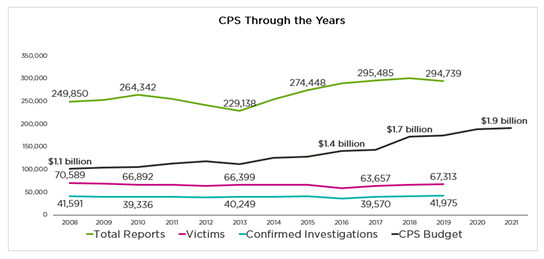Responses from 72 home visiting programs funded through Prevention and Early Intervention (PEI).


Responses from 72 home visiting programs funded through Prevention and Early Intervention (PEI).

The work of the 87th Legislature is already well underway, and TexProtects’ staff is hard at work alongside agency and legislative leaders in ensuring that Texas keeps child safety and family wellbeing at the top of the priority list this session.
Late last month, TexProtects provided recommendations in response to the Department of Family and Protective Services’ (DFPS) Legislative Budget Request (LAR). The agency’s LAR will serve as the foundation for the appropriations bill and state budget for 2022 – 2023. With the ongoing challenges of COVID-19 and the prospect of a session much more limited in scope, now more than ever, public participation and feedback on the budgetary process is critical to ensuring that communities and families can benefit from strategic investments and proven programs that ensure every child has a bright tomorrow.
You can read our comments and recommendations here, and stay tuned for more opportunities to let lawmakers know that now is the time for us all to step up and be champions for children.
TexProtects’ Stakeholder Input Department of Family and Protective Services Legislative Appropriations Request 2022-2023
Submitted November 24, 2020
TexProtects appreciates the opportunity to offer comment on the Department of Family and Protective Services’ Legislative Appropriations Request for 2022-2023. As the only statewide organization singularly focused on child protection and preventing abuse and neglect, we applaud the Department’s investments in prevention and family preservation approaches that are proven to keep children safe and keep families together.
Investments by the 85th and 86th Legislatures and innovative approaches by DFPS leadership have resulted in substantial shifts in approach that have the potential to change the landscape of child welfare in Texas in a way that is beneficial for children and families. The rollout of Community Based Care and the potential funding available through the Family First Prevention Services Act offer Texas the opportunity to invest in proven strategies, leverage community strengths, and keep kids safe.
However, despite these significant improvements, the DFPS budget still reflects a prioritization of reaction to abuse and neglect rather than prevention and family preservation. Only 5% of the 2021 budget is spent on prevention with 87% spent on Child Protective Services. The investments in CPS have increased much faster than investments in prevention without any accompanying decreases in reports, investigations, or confirmed victims.

Texas has not created a system that is effectively rolling out evidence-based practices to prevent removals and address risk before a crisis.
Impact of the COVID-19 Pandemic on Child Abuse and Neglect
Now more than ever, it is critical that the state respond correctly and provide families with proven strategies to meet their needs and to stay together safely, otherwise there is a risk of putting more stress on the system. The COVID-19 pandemic has not only negatively impacted Texas’ budget, it has caused families to face an unprecedented amount of stress, financial difficulties, and social isolation. Research during the Great Recession found significant correlations between unemployment and physical and emotional abuse. If those correlations hold in the current crisis, Texas could see a 15% increase in physical abuse cases and 12% increase in emotional abuse cases for every one-point increase in the unemployment rate.

For many families experiencing unemployment, untreated substance use and mental health challenges can increase the risks to child safety and family well-being. According to the Meadows Mental Health Policy Institute, a 5% increase in the unemployment rate could result in 300 additional lives lost to suicide, 425 additional lives lost to drug overdoses, and an additional 50,000 cases of Substance Use Disorder each year. With more than 70% of CPS cases involving mental health and substance abuse challenges prior to COVID-19, we expect to see an even more substantial impact.
Now more than ever, protecting children requires better support for families who are facing unprecedented challenges that can impact child safety and well-being.
DFPS’ Legislative Appropriations Request (LAR)
DFPS is entering into the next biennium with a $4.5 billion baseline request, which reflects growth forecasts but is impacted by the previous 5% reductions. According to DFPS, this required making some additional funding asks just to get back to a maintenance level of operations. In a typical legislative budget cycle, one would expect numerous exceptional items above DFPS’ baseline request. However, with the current economic climate amid a pandemic and a costly ongoing federal lawsuit, DFPS’ approach to the budget is narrow in scope and only aimed at initiatives they consider to be most necessary. DFPS’ LAR includes requests for an additional $192 million to carry these out.
It is promising to see two opportunities for additional prevention investments to keeping families safely together and preventing removals reflected in the Exceptional Item Requests.
These initiatives and associated dollars are focused on keeping children safe and supporting families to ensure that reports, investigations, and child abuse/neglect rates decrease. The only path toward a better Texas tomorrow and decreasing costs spent on CPS is to shift the paradigm by investing in cost-effective and proven programs BEFORE crisis. Prevention saves dollars and make sense. It’s the right approach for children and the smart approach for taxpayers.
TexProtects’ Recommendations
1 Exceptional Item Request #4 – Fully fund Prevention and Early Intervention toward Strategic Growth
While the CPS system plays a vital role for children who have endured abuse and/or neglect, the Department of Family and Protective Services (DFPS)also plays a critical role in the prevention of abuse and neglect and the strengthening of families through effective prevention programs. The Prevention and Early Intervention Division at DFPS has established innovative and effective community-based strategies for delivering proven programs to families who choose to enroll.
The immense research done on the health implications of Adverse Childhood Experiences (ACEs)[i]—including abuse, neglect, family violence, or growing up with a caregiver who is incarcerated, mentally ill, or engaging in substance use—makes clear that what happens in early childhood literally lasts a lifetime. The prevention of ACEs holds incredible potential for ensuring healthy development and impacting societal challenges and taxpayer costs across multiple domains.
The cost of inaction is clear. ACEs like child abuse and neglect are associated with negative outcomes for individuals across the lifespan including poorer health, lower educational attainment, and higher likelihood of experiencing unemployment. Individuals and governments incur significant costs as a result. Bellis et al. (2019) estimate that annual healthcare costs attributable to ACEs across North America are approximately $748 billion with 82% of costs resulting from individuals who had two or more ACEs.[ii] With one in 10 American children living in Texas, we can expect to incur a significant percent of those costs if we aren’t better able to prevent child abuse, neglect, and other severe childhood trauma.
To create the most effective and efficient systemic change, interventions should occur in early childhood and should rely on evidence-based approaches that decrease risk and increase protective factors within family and community systems.
Specifically, we applaud the increase in Project HOPES and the Military Families Program which have implemented evidence-based home visiting strategies for families with young children. These programs are proven to have significant impacts on maternal and child health, school readiness, and child safety during the most critical years for development and have been a lifeline for families during the COVID-19 pandemic.
HB1549 (85R) directed the agency to create a strategic plan to scale prevention programming. The current PEI strategic plan indicates that to adequately protect families, a 20% increase in prevention funds is needed every biennium.
While this exceptional item does reflect a 6% increase for PEI budget and an 11% increase in the number of families who could be served by PEI, it still offers less than 4% of families with young children and 3 or more risk factors access to proven evidence-based home visiting.
$18 million additional dollars (on top of the request) would allow Project HOPES to expand so that they could reach at least 5% of families most likely to benefit, would be more in line with the growth goals in the PEI strategic plan, and would create a meaningful path toward statewide scale of proven prevention programs.
2 Exceptional Item Request #5 – Prioritize Prevention in Appropriating Funds for Family First Prevention Services Act (FFPSA)
FFPSA provides Texas with a tremendous opportunity to transform the system from one that primarily responds after a crisis has occurred to one that invests in prevention to ensure families can remain together when safe and appropriate, have the supports they need, and avoid the trauma of a removal. In fact, FFPSA is the greatest investment and shift in the child welfare system from the Feds in the past five decades and if Texas doesn’t act, we will miss out on the opportunity to shrink our foster care system. FFPSA creates a funding mechanism for prevention services so that states can now be reimbursed at a rate of 50% for trauma-informed and evidence-based substance use, mental health, and in-home parenting services that have been approved by the Title IV-E Prevention Services Clearinghouse. Federal eligibility criteria broadly include children at imminent risk of entering foster care and their caregivers, as well as pregnant or parenting foster youth. The goal is to keep children out of the Child Protective Services (CPS) system by utilizing providers in the community who specialize in prevention.
DFPS released their strategic plan on September 1, 2020 which includes an overview of existing prevention services and agency activities that align with FFPSA, as well as implementation considerations and options for the prevention services and congregate care components of the bill using federal dollars already in hand from the Family First Transition Funds Act (FFTA). The plan does not require additional appropriations from the 87th Legislature and does not propose investment of any state dollars to receive the federal match that FFPSA affords. It does little to set up a framework for how to take advantage of this potentially transformational federal funding on an ongoing basis; therefore, there will still need to be planning in the 88th Legislature if this is not addressed now. Much can be done now to ensure Texas leverages this federal legislation and funding opportunities. The Department is awaiting direction from the 87th legislature on how to spend the recommended $33.9 million on prevention services for families whose children are at imminent risk of entering foster care.
The prevention provisions of FFPSA are ultimately optional, so the Department’s plan to use $33.9 of the $50.3 million in FFTA funds on prevention efforts shows great promise. Prior to FFPSA, states focused dollars on measures that are expensive and reactive rather than proactive, protective, and cost-efficient. The further into the system a case flows, the more expensive it is. In 2019, there were 18,615 children who entered foster care. Preventing 3% of those removals would save the state $20 million. By investing earlier, Texas can prevent removals, save money, and keep children safe.

DFPS laid out a wide range of options in their strategic plan. In partnership with lawmakers during this session as well as future sessions, it is essential to identify which strategies are most effective and can be replicated well in diverse communities around the state.
The most promising options leverage the expertise that has been developed within DFPS’ PEI division. These services are not staffed or carried out by employees of DFPS. Instead, PEI contracts with community providers who are highly-skilled in prevention work to provide voluntary services. Similar approaches can be utilized to fund community block grants and targeted approaches to reach families at higher risk while still empowering community leadership, strengths, and choice.
Options 2D, 2E, and 2F in the FFPSA plan are most poised to deliver proven programs to the FFPSA defined population in the coming biennium and as written could offer pilot programming to over 3,000 families at risk of removal including pregnant and parenting foster youth.
These options leverage established and successful infrastructure and programs with experience, serving FBSS families, who fit the eligibility definition. Additionally, several of the programs already implemented by PEI are approved by the Clearinghouse, including Healthy Families America, Nurse-Family Partnership, and Parents as Teachers and could be used to draw down the federal match.
Increased investment in those three options from available FFTA funds could empower pilots in more communities as well as exapnsion into rural communiites through tele-health and in-person modalities. A more focused investment in pilot approaches most likely to succeeed would result in closer to 5,000 families served before the next legislatative session. This would provide the next legislature more information to decide how and where state general revenue investments could be most impactful to communities and the budget by maximizing the federal match.
Family-Based Safety Services (FBSS) is the stage of service within DFPS that is tasked with providing services to families who have experienced child abuse and neglect but that has not risen to the level of requiring a removal. This stage of service is meant to keep families together and strengthen their ability to be healthy without further CPS intervention.
DFPS has proposed that families participating in FBSS are one of the primary targets for FFPSA prevention services. Unfortunately, DFPS does not publicly report which supports and services are provided to these families. Anecdotally, DFPS has shared that these services are primarily not evidence-based. FFPSA provides an opportunity to do something different by providing these families with evidence-based, trauma-informed services.The state spent $94 million on FBSS to serve 18,000 families in 2019. That money should be spent more wisely. Taking advantage of the opportunities in FFPSA could allow Texas to ensure that families are receiving evidence-based services proven to keep children safe. By doing so, we could finally decrease the recurrance rate among FBSS families. Diverting 5% of families from FBSS could save approximately $9.4 million.

The match available through FFPSA is for mental health, substance use, and in-home parenting supports; however, the strategic plan does not provide a meaningful pathway toward increasing access to behavioral health services which are both severely lacking in our state and clearly identified as root causes of abuse and neglect.
Texas should ensure that the budget of each state agency who provides these services to families has been considered to see if there are any missed opportunities to draw down federal funds. Cross-agency work should be mandated to ensure that future funds can be invested in ways that capitalize on the federal match.
We know families are in need of services now, so the state should consider investing its own dollars, not just the federal dollars it already has, to ensure more families can be served and to provide a meaningful and sustainable path forward for these critical prevention services.
Carrying out the opportunities provided by FFPSA requires a drastic perspective shift. The intent of FFPSA is to transform the current system, not keep it the same. FFPSA aims to invest early in effective measures that will keep families together and out of the CPS system. Every dollar Texas invests should be spent with this in mind. With their current plan, DFPS has taken strides in the right direction for the children and families of Texas. However, it is essential that the Texas Legislature supports these efforts, makes a plan beyond this legislative session, and ensures the focus remains on child abuse and neglect prevention and family preservation.
TexProtects looks forward to serving as a resource and partner as you continue your work. Thank you for your commitment to these issues and to the families and children of Texas.
[i] Felitti, V. J., Anda, R. F., Nordenberg, D., Williamson, D. F., Spitz, A. M., Edwards, V., Koss, M. P., & Marks, J. S. (1998).
[ii] Bellis et al (2019)

As part of our home visiting campaign, we’re bringing you stories from home visiting programs in Texas. Read our full home visiting landscape report here. This story comes from DePelchin Children’s Center, a nonprofit accredited foster and adoption agency with locations in Houston, Austin, Lubbock, and San Antonio. As one of the lead contractors for Project HOPES, DePelchin is utilizing state funds through the Prevention and Early Intervention Division (PEI) at the Department of Family and Protective Services to provide a continuum of evidence-based prevention programs that best meet the needs of their local communities. To learn more about Project HOPES, you can access our one pager here. To learn more about the amazing work of DePelchin Children’s Center, read on.
DePelchin Children’s Center has a history of providing prevention services to families through counseling and parenting programs. In talking with parents, they would often report that they were feeling isolated and “at their wits’ end” with their children. They simply felt they did not have the tools they needed to parent effectively. Some parents even shared the fear that they were at risk of handing their children over to the state because they just didn’t know what to do. They would say things like “I yell, I spank, I take things away and nothing works.” Parents were afraid to ask for help because asking for help meant that they were a “bad parent” or taking a class meant they were involved with CPS. The Healthy Outcomes through Prevention and Early Support (HOPES) program changed all that.
DePelchin’s HOPES program, which we call Parenting Help, allows parents to normalize parenting issues and makes it easy to ask for help. It shows the community that parenting is hard for all people. Struggles in parenting cross all racial and socioeconomic lines. Parents truly love their kids but just do not know what to do with them. We recognized that parents were not happy with how they were raising their children but did not know a different way. People would laughingly say that “my kids don’t come with an instruction manual–what am I supposed to do?” This is what helped us create the idea of Parenting Help and the tagline “Kids don’t come with instruction manuals – we can help. Parenting Help.”
Many say that it takes a village to raise a child, and we realized it would take a collaboration. We created partnerships with other child and family service agencies to provide a menu of options under the HOPES program to give parents what they need instead. In addition to the formal partnership funded by HOPES, the agencies involved connected with other child serving agencies throughout the community to form the Parenting Help Collaborative. This group meets regularly to support and leverage resources and make sure HOPES families receive what they need.
Families complete the HOPES Parenting Help program and report that they enjoy coming home from work and spending time with their child rather than avoiding them. This program gives us the opportunity to see parents encourage change in their children’s behavior so things like going to the grocery store after a long day are no longer a struggle. They learn how to count apples and sing songs down the aisle while praising their children and how this increases positive behavior while also managing misbehavior. Parents learn they can manage their children’s behavior, teach their children a skill, and spend quality time all in the same moment. It is so empowering for these families who at first felt so out of control with their children to realize that they now have the ability to help their child behave in positive ways. They now know they are the most important person in that child’s life and can make a huge impact.
HOPES has allowed us to implement these services in each county in a way that best meets the needs of that community. Not every community is the same and we can tailor each program to what the parents and children in that county need. We are so grateful for the HOPES program and blessed to be part of seeing these changes in families.

TexProtects would like to thank Julie Crowe, Charity Eames, and Megan Green at DePelchin Children’s Center for their tireless work for children and families and for sharing their Project HOPES story through this blog.

In this special edition of Frontline for Children, we take a deep dive into the latest research and resources on home visiting as part of our #HomeVisitingIsEssential campaign.

TexProtects Takeaway: Home visiting saves dollars and makes sense. Investments in home visiting programs demonstrate positive impacts and cost savings across two generations and multiple domains including child abuse prevention, maternal mental health, child health, economic stability, and school readiness. However less than 4% of Texas families that could most benefit from these programs currently have access. Now more than ever, it is critical that we do more of what works and less of what doesn’t. Home visiting works, and Texas needs to do more to support families so that they can ensure healthy beginnings and successful futures for their children.
The fourth release of TexProtects’ Home Visiting in Texas report. In it, we overview the landscape of home visiting, including history, families and communities served, funding, return on investment and demonstrated outcomes, and program descriptions. We hope it will serve as a useful resource for those new to home visiting and advocates in need of tools to communicate about its footprint and impact.
Home Visiting Advocacy Toolkit
Resources, templates, and talking points for supporting home visiting during the 87th Texas Legislative Session – all in six steps. Join us as we spread the message that #HomeVisitingIsEssential.
Future Directions for Home Visiting in Texas (with Child Trends)
This report looks to the future of home visiting in Texas by outlining 5 innovative strategies to help increase quality and expand access including partnering with multiple state agencies, leveraging technology, addressing workforce challenges, expanding connections with other systems, and using precision research.
“Two fields—medicine and behavioral health—have explored the use of telehealth, defined as the use of electronic platforms such as video, texting, or online content to support long-distance health services. Studies comparing in-person and telehealth models have generally found similar outcomes across the two modes of service. Because of the overlap between the kinds of services that both telehealth services and home visiting programs provide—including assessment, information sharing, and support—lessons learned from telehealth can be valuable to home visiting.”This blog applies telehealth research to the HV field.
Advancing Home Based Parenting Programs Through the Use of Telehealth Technology (Traube, D., Hsiao, H., Rau, A., Hunt-O’Brien, D., Lu, L., & Islam, N.)
“Home-based parenting programs have demonstrated impact on the prevention of child maltreatment, promotion of child screening and health care, and increased school readiness. However, cost and time resources make access to home-based parenting programs limited. Telehealth delivery systems may help to fill this gap, reducing barriers and expanding the reach of home-based parenting programs. This manuscript describes a pilot feasibility study focusing on model fidelity for delivering a home-based parenting program (Parents as Teachers) via a university-based telehealth interactive video conferencing technology. Results indicate that the program was able to meet all fidelity measures related to supervision, training, and curriculum delivery.”
Implementation of a telehealth-enhanced home visiting programme for families of young children (Jetelina, K., Oke, O., Rodriguez, P., Weerakoon, S., & Barlow, S.)
“A large pediatric healthcare system implemented a telehealth-enhanced home visiting program as an extension of primary care services.” Results of this evaluation suggest that “Once families were enrolled, the program was fairly successful in addressing patient outcomes. The program and visit process was highly regarded by families and the unlicensed healthcare professionals. Future program recommendations, such as small programmatic changes and major improvements in the clinic, should be implemented before widespread dissemination.”
COVID-19’s Early Impact on Home Visiting: First Report of Results from a National HARC-Beat Survey of Local Home Visiting Programs (Home Visiting Applies Research Collaborative – HARC)
“This HARC-Beat survey “took the pulse” of local programs nationally in their early efforts to adapt to disruptions arising from the pandemic. It included all local programs regardless of model or funding sources. It aimed to provide useful information to advance the field overall in helping individual programs adapt to the pandemic, for example through efforts such as the Rapid Response Initiative.” Among other things, the survey asked about social distancing policies, changes to the HV workforce, and challenges in shifting to virtual formats.
Reflective parenting home visiting program: A longitudinal study on the effects upon depression, anxiety, and parenting stress in first-time mothers (Vismara, L, Sechi, C., & Lucarelli, L.)
“Our study aimed to investigate the effects of a reflective parenting home visiting program in first time-mothers at risk for depression, anxiety, and parenting stress, from three to 12 months after their child’s birth… Our findings confirm the benefits of reflective parenting home visiting programs and underline the need to constantly evaluate the levels of depression, anxiety and parenting stress throughout the perinatal period to target effective prevention programs to foster early mother-child attachment bond.”
Addressing maternal mental health to increase participation in home visiting (Molina, A., Traube, D., & Kemner, A.)
“This study aimed to examine rates of depression among mothers in the national Parent as Teachers (PAT) home-visiting program, whether various high needs characteristics were associated with elevated depressive symptoms, and whether depressive symptomology and initiation of outside mental health treatment were associated with attendance and retention in services, particularly after considering important family risk factors… Results demonstrate that mothers with higher depressive symptoms, including those in the subclinical range, have a harder time participating in home-visiting services, even though they may need the support the most. However, when PAT home-visitors address maternal mental health and mothers initiate treatment, mothers appear to be better equipped to participate in home visiting.”
Addressing maternal depression in home visiting: Findings from the home visiting collaborative improvement and innovation network (Tandon, D., Mackrain, M., Beeber, L., Topping-Tailby, N., Raska, M., & Arbour, M.)
“Maternal depression is common among low-income women enrolled in home visiting programs, yet there is considerable variability in the extent to which it is identified and addressed. This study examines outcomes related to postpartum depression screening, receipt of evidence-based services, and reductions in depressive symptoms among clients of home visiting programs in the Health Resources and Services Administration’s Maternal, Infant, and Early Childhood Home Visiting Program Home Visiting Collaborative Improvement and Innovation Network (HV CoIIN)…” Findings suggest that “Home visiting programs can play an important role in closing gaps in maternal depression identification, referrals, service access, and symptom alleviation.”
Home Visiting Career Trajectories (Office of Planning, Research & Evaluation, Urban Institute)
“A stable and qualified workforce is crucial for the effective delivery of early childhood home visiting services, yet little information exists on this workforce nationally and across home visiting models… The Home Visiting Career Trajectories project launched in fall 2016 to fill this knowledge gap. Using multiple methods, the study examined the characteristics, qualifications, and career trajectories of home visiting staff in local implementing agencies (LIAs) that receive funding through the Maternal, Infant, and Early Childhood Home Visiting (MIECHV) Program. The findings provide nationally representative descriptive information on the home visiting workforce in MIECHV-funded agencies across the US.”
Parent Involvement in Maternal, Infant, and Early Childhood Home Visiting Programs: an Integrative Review (Bower, K., Nimer, M., West, A., & Gross, D.)
“Despite the evidence and investment in evidence-based federally funded maternal, infant, and early childhood home visiting, substantial challenges persist with parent involvement: enrolling, engaging, and retaining participants. We present an integrative review and synthesis of recent evidence regarding the influence of multi-level factors on parent involvement in evidence-based home visiting programs.” Findings suggest that “Future research should move beyond the study of parent- and family-level characteristics and focus on program- and home visitor–level characteristics which, although still limited, have demonstrated some consistent association with parent involvement. Neighborhood characteristics have not been well studied and warrant future research.”
Intention to Engage in Maternal and Child Health Home Visiting (Turner, M., Cabello-De la Garza, A., Kazouh, A, Zolotor, A., Kilka, J., Wolfe, C., & Lanier, P.)
“This qualitative study used a Reasoned Action Model (RAM) and a cultural lens to explore factors influencing the engagement of women with low-income in HV programs… The constructs most salient for participants were emotions and affect, behavioral beliefs, and self-efficacy. In the context of an urban public health prenatal clinic, HV marketing and outreach should highlight convenience and social support, as well as clearly communicate program content and intent. In practice, HV programs must be flexible to work around work and home schedules; marketing and outreach should emphasize that flexibility.”
Strengthening Family Retention and Relationships in Home Visiting Programs through Early Screening and Assessment Practices (Barton, J., Jimenez, P., Biggs, J., Garstka, T., & Ball, T.)
“Evidence-based home visiting (EBHV) programs for pregnant women and families of young children prevent child maltreatment and improve maternal and child health outcomes. However, home visiting programs often struggle to retain families long enough to achieve positive outcomes. The current study sought to understand how home visitor relationship building skills and screening practices predict families’ duration in EBHV… Results suggest that screening practices may help build relationships with families which then enhances retention in services and increases the likelihood of achieving positive maternal and child outcomes.”
National Home Visiting Resource Center
“The NHVRC Reference Catalog features home visiting research and evaluation, including evaluation plans, research briefs, conference and poster presentations, cost studies, and fact sheets.” Resources can be sorted by specific topic, data collection methods, home visiting model type, and date of publication.
Rapid Response Virtual Home Visiting Collaborative (Institute for the Advancement of Family Support Professionals)
“The Rapid Response-Virtual Home Visiting collaborative (RR-VHV) will provide best practice principles and strategies to support all home visiting professionals in maintaining meaningful connection with families during this time of increased anxiety and need. Through collaboration, the RR-VHV will leverage the extensive resources and expertise that exists across home visiting organizations to support the development and distribution of cross-model, cross system approaches and guidance. Providing immediate support for our front-line home visiting staff and the families they serve is our highest priority.”The website houses a host of resources for HV professionals on topics such as family engagement, supervision, technology, and screening, as well as a bank of RR-VHV Webinar Recordings.
Important Home Visiting Information During COVID-19 (U.S. Health Resources & Services Administration, Maternal & Child Health – HRSA)
This page features guidance from HRSA, encouraging “family support programs to offer prevention and family strengthening strategies virtually and through other safe means during the COVID-19 pandemic.” The site also has informational sections covering The Role of Home Visiting During a Public Health Emergency; Identifying Risks (for face-to-face home visits); Precautions for Home Visitors; Self-Care and Managing Stress; FAQs for Home Visiting Grantees; and Additional Resources for women and families, social service providers, and health care professionals.

An overview of the home visiting landscape, including history, families and communities served, funding, return on investment and demonstrated outcomes in Texas.

Strategies that can be used to finance expansion, innovation, engagement, and workforce stabilization of home visiting services.

6 ways to advocate for home visiting programs.

The bond between a mother and child is special. Because that connection is so profound, wellbeing for an infant is largely determined by the physical and mental health of their mother. According to the American College of Obstetricians and Gynecologists (ACOG), Post-Partum Depression (PPD) is one of the most common threats to maternal mental health, affecting approximately 600,000 women a year. It is estimated that 14% to 23% of mothers will experience depression at some point during pregnancy and 5%-25% experience PPD. All women who give birth are potentially at risk. Despite that fact, many mothers with PPD struggle with guilt or shame. While PPD is highly treatable, fear of being labeled a bad mother can make it hard for women to discuss the issue or reach out for the help they need.
Symptoms of PPD include feelings of anger, crying more often than usual, withdrawing from loved ones, feeling distant from the baby, worrying or feeling overtly anxious, thinking about hurting yourself or the baby, and doubting one’s ability to care for the baby. These feelings of being unable to connect to the baby can be particularly unsettling for new mothers and particularly disruptive to the attachment and responsiveness which underlies health child development. Because the first three years of life are so foundational, untreated PPD can have lifelong consequences for children.
Simple acts of care such as hugs, smiles, and lullabies create new brain pathways for infants which develop their capacity to form memories, relationships, and logic. Post-partum depression can weaken the mother-child bond, stunting cognitive and linguistic development. A number of other negative outcomes have been linked to PPD, such as higher rates of behavioral problems and lower grades. If essential neural pathways are not formed during early childhood, they may never develop. This means that treatment is especially time sensitive; early treatment allows moms to fully bond with their children as soon as possible and to optimize their child’s early developmental period. TexProtects advocates for improving post-partum mental health and other issues which impact a child’s crucial development period through our Prenatal to Three Policy Agenda.
Destigmatizing PPD and supporting mothers with mental healthcare will help ensure every child in Texas has a strong start. Last legislative session, HB 253 mandated the creation of a five-year strategic plan to raise public awareness around PPD and to improve access to mental health screening, referral, treatment, and support services. The Texas Health and Human Services Commission (HHSC) recently released their initial draft of the Post-Partum Depression Strategic Plan for public comment. TexProtects submitted comments on that draft plan that included the following key recommendations:
Increasing healthy beginnings and supporting young families are critical components of our Prenatal to Three Policy Agenda. Learn more about our work to ensure infants and toddlers (and their families) have what they need to be safe and well and maximize the potential of the early years of development.

Maternal and Child Health Inequities Emerge Even Before Birth (Child Trends)
Highlighting findings from the State of Babies Yearbook: 2020, this brief focuses on the evident disparities in maternal health and birth outcomes among babies and families of color: “To have a healthy pregnancy and positive birth outcomes, women and their infants require access to appropriate health care services, before, during, and after birth.”

TexProtects’ Takeaway: Black and Indigenous babies have a much higher risk of birth complications, low birthweight, and death within their first year of life in comparison to white babies. To achieve the strongest possible outcomes for all, we must meaningfully address health disparities in our communities, beginning with the earliest days of each child’s life.
Tracking COVID-19’s Effects by Race and Ethnicity (Urban Institute)
To work toward an equitable recovery for all U.S. citizens, policymakers and practitioners should pursue solutions that acknowledge and account for COVID-19’s disparate impact on communities of color. “To design these race-conscious policies, policymakers need data to gauge how the pandemic may be affecting people’s health, housing, and livelihoods. This tool uses the near-real-time Household Pulse Survey data to track a set of measures for US households as the pandemic and recovery unfold.”

TexProtects’ Takeaway: The onset of this health crisis has further exposed how systemic racism is creating harmful disparities between white communities and communities of color. The Texas Health and Human Services Commission (HHSC) is taking the first step and has recently announced that it is seeking to remedy the lack of information about how Black and Latinx/Hispanic communities are affected by the virus. All labs that test for COVID-19 are now required to collect information on race, ethnicity, and other factors.
Start with Equity: From the Early Years to the Early Grades (Bipartisan Policy Center & The Children’s Equity Project at Arizona State University)
“Millions of young children are disproportionately underserved, over-punished, and barred from high-quality education in American schools…. The Children’s Equity Project and the Bipartisan Policy Center have come together to create an actionable policy roadmap for states and the federal government—as well as for candidates at all levels of government vying for office—to take meaningful steps to remedy these inequities in early learning and education systems.”

TexProtects’ Takeaway: More than half of the children in the United States are children of color. COVID-19 is exacerbating the inequitable distribution of opportunity in our education system. This policy agenda supports fully funding programs like Head Start, requiring states to report plans on who they will work to make learning systems more equitable, supporting and funding equitable educator training, and ensuring all education legislation prioritizes racial, ethnic, linguistic, socioeconomic, and ability-based integration.
Health Care Access for Infants and Toddlers in Rural Areas (Child Trends)
“While many public reports provide indicator data on rural health care access at the national level, this brief uses data from the State of Babies Yearbook: 2020 to examine state-level differences in how infants and toddlers living in rural areas are faring. Equipped with these data, state policymakers can explore strategies to support the needs of very young children and their families.”

TexProtects’ Takeaway: Only 0.5% of infants and toddlers in Texas who could benefit from evidence-based home visiting (HV) programs are receiving those services. This upcoming legislative session, policymakers in Texas must identify why there are gaps in how existing HV programs serve rural children and families.
As schools reopen, addressing COVID-19-related trauma and mental health issues will take more than mental health services (Child Trends)
To address COVID-19 related trauma and mental health concerns amongst students, Child Trends recommends that decision-makers in education take a comprehensive approach that extends beyond offering school-based mental health services. Such an approach includes (but is not limited to) educating all school staff about trauma and mental health; acknowledging that not every community has experienced the pandemic in the same way; and ensuring that school staff know how to connect students to community-based mental health resources.

TexProtects’ Takeaway: Through the passage of HB 18, the Texas Legislature took a step last session to ensure that all school staff are adequately trained to understand the impact of trauma on students, implement strategies to minimize the negative impacts, and maximize academic opportunities in an environment of safety and connection, making referrals when needed and with parental consent. Policymakers and organizations like TexProtects must hold school districts accountable and ensure that these mandatory trainings are taking place in a timely fashion.
To support infant development, states can encourage parents to read, sing, and tell stories with their children (Child Trends)
“Here’s an easy, evidence-based, and low-cost investment for early childhood leaders and policymakers to promote young children’s development, empower parents, and strengthen families: Encourage parents and other caregivers to read, sing, and tell stories to their children. It’s that simple.”

TexProtects’ Takeaway: Building the caregiver-child bond through singing, reading, and telling stories contributes to strengthening resiliency and encouraging literacy skills and cognitive and socioemotional intelligence in young children.
Different brain profiles in children with prenatal alcohol exposure with or without early adverse exposures (Andre, Q., McMorris, C., Kar, P., Ritter, C., Gibbard, B. Tortorelli, C., & Lebel, C.)
“Prenatal alcohol exposure (PAE) has been linked with widespread brain abnormalities including reduced brain volume, altered cortical thickness, and altered white matter connectivity. Fetal alcohol spectrum disorder (FASD), the neurodevelopmental disorder associated with PAE, is the most common cause of preventable developmental disabilities in children… The goal of this study was to determine how PAE in the presence or absence of postnatal adverse exposures is associated with brain structure and mental health symptoms in children.”

TexProtects’ Takeaway: This research contributes to a long line of research on adverse childhood experiences (ACEs) and how they shape the physical and mental brain health of children. TexProtects is working with policymakers on legislation that would create a framework in Texas on how to mitigate and treat ACEs on a statewide level to ensure the health of every child.
Father-child play: A systematic review of its frequency, characteristics and potential impact on children’s development (Amodia-Bidakowska, A., Laverty, C., & Ramchandani, P.)
This paper reflects a systematic literature review of publications in psychological and educational databases (until the year 2018) to “characterize the nature and potential impact of father-child play” for children ages 0-3. Given their findings, the authors suggest that father-child play can substantially benefit children’s development, which “provides a clear imperative for policy makers and practitioners to facilitate and support fathers, as well as mothers, in developing more positive and playful interactions with their infants.”

TexProtects’ Takeaway: Fathers matter! Encouraging strong father-child relationships is part of building protective factors for resiliency in children. This report enforces that early father-infant play is linked to positive social, emotional, and cognitive outcomes.
African American, American Indian, and Alaska Native children are all more likely to live in grandfamilies – “families in which grandparents, other adult family members or close family friends are raising children with no parents in the home” – than other racial or ethnic groups. The following two reports by Generations United are intended to support child welfare or other government agencies, as well as nonprofits, to better serve the grandfamilies with which they work:

TexProtects’ Takeaway: Children of color are dramatically overrepresented in kinship care both within and without the formal foster care system. Historically, there has been a severe lack of support and services for these families – especially those that are culturally appropriate.
Road to Resilience: Raising Healthy Kids (Mayo Clinic Health System)
“This six-week virtual program will help you and the youth in your life combat the effects of Adverse Childhood Experiences (ACEs). There are a variety of resources in linked pages on this site that you and your youth should review at your own pace. You can read content, watch videos or do activities.”

TexProtects’ Takeaway: Adverse childhood experiences (ACEs) can lead to negative mental and physical health effects later in life. This tool is a great way to help build resiliency against these potential negative outcomes so that ACES do not dictate a child’s future.
Using Media Effectively with Young Children and Virtual Visitation (Youth Law Center & Quality Parenting Initiative)
“While in-person visitation is the best way to support families, it isn’t always possible during this emergency. Now more than ever, it is critically important that birth and foster parents partner together to ensure that children experience continuity of relationships and can maintain contact with the people they love.” This brief shares research and practical suggestions from Dr. Rachel Barr, an expert in media and young children, to help parents navigate and make the best of virtual visitation with their young children.

TexProtects’ Takeaway: Virtual visitation can be used to maintain and strengthen relationships for young children. Learn how to navigate difficulty holding a child’s attention, problems with eye contact and sharing attention, loss of physical contact, technical problems, and toddler independence.